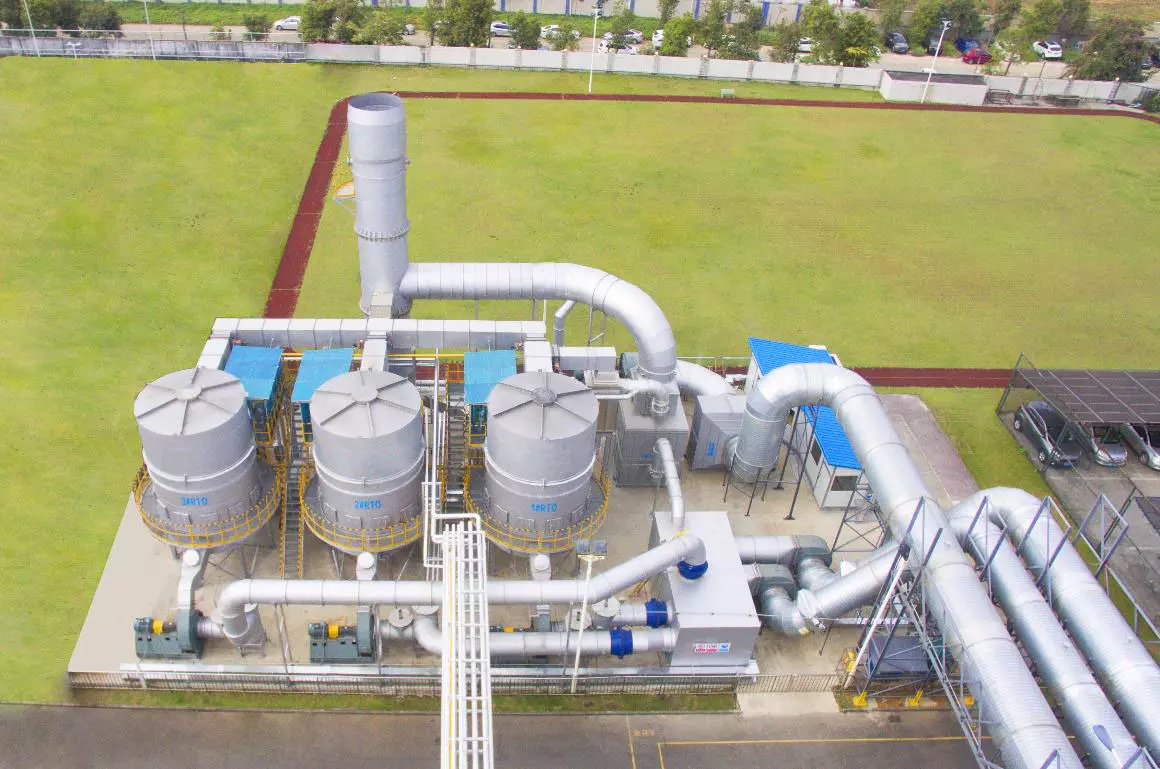How efficient is an RTO thermal oxidizer?
Introducere
An RTO (Regenerative Thermal Oxidizer) is an advanced air pollution control technology used in industrial processes to efficiently remove harmful pollutants from exhaust gases. It utilizes high temperatures and a regenerative process to achieve effective oxidation of volatile organic compounds (VOCs) and hazardous air pollutants (HAPs). In this blog post, we will explore the efficiency of an Oxidant termic RTO
and its various aspects.
Working Principle
– RTOs operate on the principle of thermal oxidation, where the pollutants in the exhaust gas are thermally decomposed into carbon dioxide and water vapor through combustion.
– The system consists of a combustion chamber, a ceramic heat exchange media bed, and control valves that alternate the flow of exhaust gases.
– During operation, the hot exhaust gas enters the RTO and passes through the first heat exchange media bed, transferring heat to the ceramic material.
– The heat-loaded media bed is then isolated from the incoming exhaust gas stream, and the flow is redirected to the second media bed.
– As the exhaust gas passes through the second bed, the heat is transferred to it, while the first bed is purged with clean air to remove any remaining pollutants.
– This alternating flow and heat exchange process result in high thermal efficiency and minimal energy consumption.
Factors Affecting Efficiency
1. Temperature Control:
– Maintaining optimal operating temperatures is crucial for the efficiency of an RTO.
– Higher temperatures promote better combustion and VOC destruction efficiency.
– However, excessively high temperatures may cause thermal damage or increase energy consumption.
2. Concentration and Composition of Pollutants:
– The efficiency of an RTO depends on the concentration and composition of pollutants in the exhaust gas.
– Higher pollutant concentrations may require longer residence times or additional treatment steps for effective removal.
3. Heat Recovery:
– RTOs are known for their high heat recovery efficiency, which results in lower energy consumption.
– The recovered heat can be utilized for preheating incoming gases, reducing the overall energy demand of the system.
4. Flow Rate and Residence Time:
– Proper control of the flow rate and residence time ensures sufficient contact between the pollutants and the combustion chamber.
– Adequate residence time allows for complete oxidation of pollutants, thereby improving the overall efficiency.
Advantages of RTO Efficiency
– High Destruction Efficiency:
– RTOs can achieve destruction efficiencies of up to 99% for VOCs and HAPs, ensuring compliance with stringent air quality regulations.
– The efficient combustion process results in minimal emissions and reduced environmental impact.
- Eficienta energetica:
– The regenerative process of RTOs allows for significant energy savings.
– The captured heat can be used to preheat the incoming gases, reducing the need for additional energy sources.
– Cost Savings:
– Improved energy efficiency translates into cost savings for industrial facilities.
– Lower operating costs and reduced fuel consumption contribute to the overall economic viability of RTOs.
Concluzie
RTO thermal oxidizers are highly efficient air pollution control systems that offer numerous advantages for industrial processes. Their ability to achieve high destruction efficiencies, energy recovery, and cost savings make them a preferred choice for many industries. By effectively removing pollutants from exhaust gases, RTOs play a crucial role in promoting environmental sustainability and ensuring regulatory compliance.

How efficient is an RTO thermal oxidizer?
Our company is a high-tech enterprise specializing in the comprehensive treatment of volatile organic compounds (VOCs) exhaust and carbon reduction and energy-saving technologies. Our core technologies include thermal energy, combustion, sealing, and self-control. We have capabilities in temperature field simulation, air flow field simulation modeling, ceramic heat storage material performance, molecular sieve adsorption material selection, and VOCs high-temperature incineration and oxidation experimental testing.
With a research and development center for RTO technology and exhaust carbon reduction engineering technology center in Xi’an, and a 30,000 square meter production base in Yangling, we are a leading manufacturer of RTO equipment and molecular sieve rotary wheel equipment worldwide. Our core technical team comes from the Aerospace Liquid Rocket Engine Research Institute (Aerospace Six Institute). We have over 360 employees, including more than 60 research and development technical backbones, among them are 3 senior engineers at the research fellow level, 6 senior engineers, and 9 thermodynamics doctors.
Our core products are the rotary valve regenerative thermal oxidizer (RTO) and molecular sieve adsorption concentration rotary wheel. Combined with our expertise in environmental protection and thermal energy system engineering, we can provide customers with comprehensive solutions for industrial exhaust gas treatment, carbon reduction, and energy utilization for various operating conditions.

Our company has obtained various certifications, qualifications, patents, and honors, including:
- Certificarea Sistemului de Management al Proprietății Intelectuale
- Certificarea Sistemului de Management al Calitatii
- Certificarea Sistemului de Management de Mediu
- Construction Industry Enterprise Qualification
- Întreprindere de înaltă tehnologie
- Patent for Rotary Valve Regenerative Thermal Oxidizer
- Patent for Rotary Heat Incineration Equipment
- Patent for Disc Molecular Sieve Rotary Wheel

To choose the appropriate RTO equipment, consider the following factors:
- Determinați caracteristicile gazelor de eșapament
- Înțelegeți reglementările locale și standardele de emisii
- Evaluați eficiența energetică
- Luați în considerare operarea și întreținerea
- Analyze budget and cost
- Selectați tipul adecvat de RTO
- Luați în considerare factorii de mediu și de siguranță
- Efectuați testarea și verificarea performanței
Our service process includes:
- Consultare și evaluare: Consultare inițială, inspecție la fața locului, analiza nevoilor
- Proiectare și dezvoltare soluție: proiectare soluție, simulare și modelare, revizuire soluție
- Producție și producție: producție personalizată, control al calității, testare în fabrică
- Installation and commissioning: On-site installation, commissioning and operation, training services
- Asistență post-vânzare: întreținere regulată, asistență tehnică, aprovizionare cu piese de schimb
We are a one-stop solution with a professional team that tailors RTO solutions to meet the specific needs of our customers.
Autor: Miya
